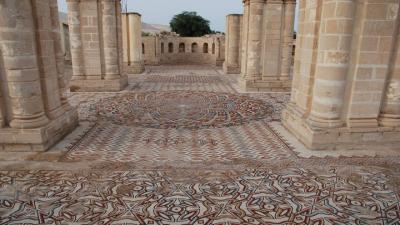Residents of the town of Sebastia in the northern West Bank, known for its archaeological sites dating back over four thousand years, fear losing these integral aspects of their social life and memories amid Israeli efforts for complete control over the area. According to Sebastia Mayor Muhammad Azam, who oversees the locality in Nablus governorate, senior Israeli army officers have recently been visiting the archaeological area. He added, "This continues a pattern of incursions in recent days and weeks, which is a precursor to implementing a larger Judaization project for the archaeological area of Sebastia and the theft of its artifacts."
The Israeli government has recently allocated 32 million shekels for the development of Sebastia's archaeological sites, which are located in an area under full Israeli control according to the temporary Oslo peace agreement between Palestinians and Israelis. This agreement divided Palestinian territories into three sections: Area A, which is under complete Palestinian control representing cities; Area B, which includes villages under Palestinian administrative control and Israeli security; and Area C, which comprises around 60% of the West Bank under complete Israeli control until a permanent peace agreement is reached. The Israeli Antiquities Authority classifies Sebastia as an Israeli archaeological site.
The Israeli Parks and Nature Authority states on its official website that Sebastia "was the capital of the Kingdom of Israel about 3000 years ago and was known as Samaria." It mentions the "Palace of the Kings of Israel" as one of the most significant archaeological sites in Sebastia, noting that "the Kings of Israel built a strong fortress on the mount, surrounded by an outer wall and an inner wall," according to a Reuters report.
Israeli delegations visit the area under army protection, and residents report that the Israeli army organizes graduation ceremonies for officers at the Roman amphitheater, one of the prominent archaeological features of Sebastia. In the late 1970s, Israel established the Shave Shomron settlement just hundreds of meters from the archaeological sites in Sebastia, and Palestinians claim that recent land leveling is occurring to expand the settlement.
According to the official website of the Palestinian Ministry of Tourism and Antiquities, "Numerous archaeological excavations conducted at the site since the early 20th century have shown that the earliest archaeological evidence dates back to the Early Bronze Age, around 3200 BC." It adds, "During the Roman period, the city witnessed an extensive construction project, which included the city wall, the western gate, a colonnaded street lined with 600 columns, as well as the basilica (the market), the public square, the theater, the Temple of Augustus, the Temple of Koury, the sports stadium, the aqueduct, and the burial sites." The site continues, "Sebastia has maintained its ancient Roman name through the Mamluk, Ottoman, and modern periods."
A group of archaeological sites in the town includes the mosque, the shrine of Prophet John, the Cathedral of John the Baptist, the Roman cemetery, the olive press, the Al-Ka'id palace, and a number of traditional buildings. Key archaeological features on the town's outskirts include the Roman amphitheater and a church and palace, many parts of which remain visible despite no restoration work being carried out over the past years.
Mayor Muhammad Azam explained that "the Israeli plans aimed at controlling the archaeological sites are beginning to materialize." He added, "The repeated incursions of the occupation army, settlement gangs, and various occupation authorities are merely a precursor to this large Judaization project." He continued, "Sebastia Municipality is one of the largest historical and archaeological sites in Palestine, and Sebastia itself has become under significant threat and targeting. The occupation government, with all its components, imposes a large encirclement around Sebastia through this project as a prelude to stealing and Judaizing antiquities."
The archaeological sites create both direct and indirect job opportunities for the residents of Sebastia due to limited local and foreign tourism. Azam stated, "There are more than 50 families in Sebastia who rely on tourism in this area... these families will lose their source of income." Samer Al-Shaar, a shop owner near the archaeological area, remarked, "Tourist activity is negatively affected by the presence of the occupation and attempts to market this place as Israeli."
The ruins in Sebastia are part of the social and cultural life of its residents, numbering around five thousand. Youth activist Zaid Azahri expressed, "Our biggest fear is the closure of the site and our isolation from it, preventing us from accessing the ancient ruins." The Palestinian Ministry of Tourism complains about being barred by Israeli authorities from operating even in areas administratively under the Palestinian Authority.
The Rozna Association, which focuses on heritage preservation, organizes field tours for groups of journalists, human rights workers, and others in the archaeological region of Sebastia. Spokesperson Viola Abdullah stated, "This tour was organized after we felt the danger because there are many claims about establishing projects and parks, as well as promotional campaigns for all settlers to come to this place and inhabit it." She added, "Therefore, the Palestinian presence is important and necessary, especially among youth, as they are the future. When they come to explore the area, it reinforces the information… presence is protection; there’s nothing else they can do but be there." The group visiting the site appeared astonished as they moved from one archaeological feature to another.




